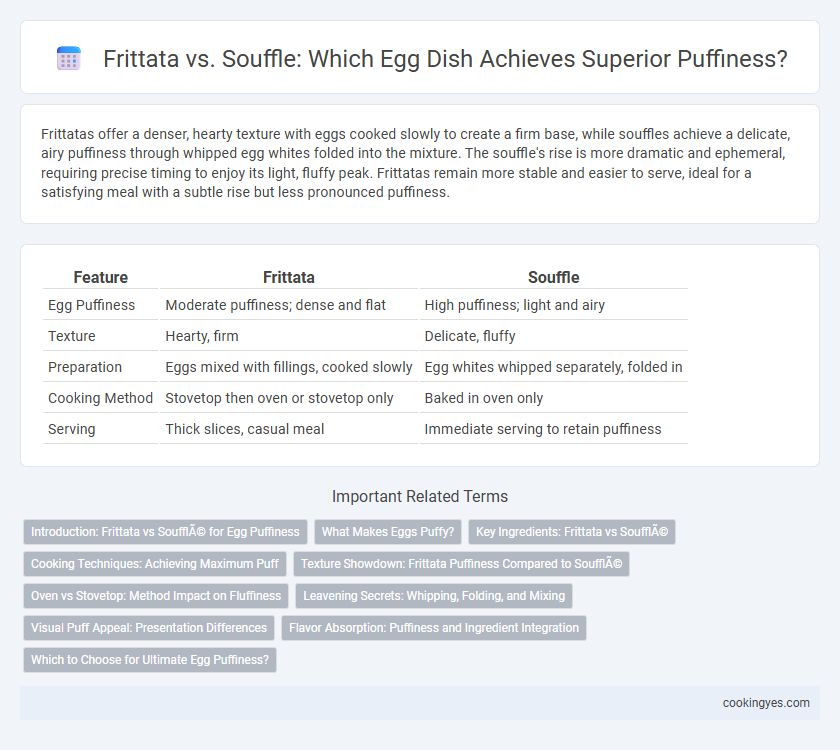Frittatas offer a denser, hearty texture with eggs cooked slowly to create a firm base, while souffles achieve a delicate, airy puffiness through whipped egg whites folded into the mixture. The souffle's rise is more dramatic and ephemeral, requiring precise timing to enjoy its light, fluffy peak. Frittatas remain more stable and easier to serve, ideal for a satisfying meal with a subtle rise but less pronounced puffiness.
Table of Comparison
| Feature | Frittata | Souffle |
|---|---|---|
| Egg Puffiness | Moderate puffiness; dense and flat | High puffiness; light and airy |
| Texture | Hearty, firm | Delicate, fluffy |
| Preparation | Eggs mixed with fillings, cooked slowly | Egg whites whipped separately, folded in |
| Cooking Method | Stovetop then oven or stovetop only | Baked in oven only |
| Serving | Thick slices, casual meal | Immediate serving to retain puffiness |
Introduction: Frittata vs Soufflé for Egg Puffiness
Frittata and souffle differ significantly in egg puffiness due to their preparation techniques and ingredient ratios. A souffle relies on beaten egg whites folded into the base mixture, creating a light, airy texture that rises markedly during baking. In contrast, a frittata combines whole eggs with various fillings and is cooked slowly, resulting in a denser, more compact texture without pronounced puffiness.
What Makes Eggs Puffy?
Egg puffiness in frittatas and souffles primarily depends on the incorporation of air into the egg mixture; souffles achieve a lighter, airy texture by folding in beaten egg whites, creating more volume and lift. Frittatas rely on whole eggs beaten thoroughly but do not separate whites and yolks, resulting in a denser, less airy structure. The chemical reaction of heat coagulating proteins in both dishes contributes to firmness, but the mechanical aeration method is the key factor in puffiness difference.
Key Ingredients: Frittata vs Soufflé
Frittata relies on whole eggs beaten with vegetables, cheeses, and meats, providing a dense, hearty texture without much rise. Souffle uses whipped egg whites folded into the base mixture, creating a light, airy puffiness that rises significantly in the oven. The primary difference lies in the incorporation of whipped egg whites, which is essential for the souffle's characteristic volume and delicate structure.
Cooking Techniques: Achieving Maximum Puff
Frittatas achieve egg puffiness by slow cooking over low heat, allowing eggs to set gradually and air to incorporate without collapse, resulting in a dense yet tender texture. Souffles rely on folding whipped egg whites into the base mixture, then baking at high heat to create a light, airy puff that rises dramatically. Mastery of gentle heat control in frittatas and precise egg white folding in souffles is essential for maximizing puffiness in each dish.
Texture Showdown: Frittata Puffiness Compared to Soufflé
Frittatas have a denser, heartier texture with moderate puffiness due to the incorporation of whole eggs and a slower cooking method, resulting in a firm yet tender bite. In contrast, souffles achieve maximum puffiness through whipped egg whites folded into the base, creating a light, airy texture that rises dramatically during baking but deflates quickly after removal from heat. The texture showdown highlights that while souffles prioritize delicate, cloud-like puffiness, frittatas offer a more substantial, rustic fluffiness suitable for hearty meals.
Oven vs Stovetop: Method Impact on Fluffiness
Frittatas are typically cooked on the stovetop and finished in the oven, resulting in a dense yet tender texture with moderate puffiness, while souffles rely solely on oven baking, which creates a light, airy structure due to the whipped egg whites. The stovetop method in frittata cooking allows for gradual cooking that sets the eggs without excessive rise, whereas the high and even heat of the oven encourages the souffle to expand and achieve maximum fluffiness. Oven temperature and timing are critical for souffles to maintain their puffiness, whereas frittatas offer a more consistent, slightly less puffy texture because of their combined stovetop-oven preparation.
Leavening Secrets: Whipping, Folding, and Mixing
Frittatas achieve egg puffiness primarily through careful folding of partially set eggs rather than extensive whipping, resulting in a denser, creamier texture. Souffles rely heavily on whipping egg whites to stiff peaks, incorporating air that acts as a natural leavening agent for a light, airy rise. Mastery of mixing techniques--gentle folding for souffles and minimal disturbance for frittatas--is essential to optimize the delicate structure and volume in each dish.
Visual Puff Appeal: Presentation Differences
Frittatas have a denser, flatter surface with slight puffiness and visible ingredients like vegetables and cheese, offering a rustic and hearty presentation. Souffles achieve dramatic height and an airy, cloud-like appearance with a smooth, rounded top that deflates shortly after baking, creating an elegant visual puff appeal. The visual puffiness in souffles emphasizes lightness and delicacy, whereas frittatas highlight a robust, textured look.
Flavor Absorption: Puffiness and Ingredient Integration
Frittatas offer superior flavor absorption due to their dense, open structure, allowing ingredients like vegetables, cheese, and herbs to meld seamlessly throughout the egg base. Souffles deliver impressive puffiness with a light, airy texture created by whipped egg whites, but their delicate structure limits deep flavor integration. Consequently, frittatas provide richer, more evenly distributed taste, while souffles emphasize texture and presentation over ingredient fusion.
Which to Choose for Ultimate Egg Puffiness?
Frittatas offer a dense, savory egg dish that puffs modestly through beaten eggs and slow cooking, ideal for hearty, flavorful meals. Souffles achieve ultimate egg puffiness using whipped egg whites folded into yolks, creating a light, airy texture that rises dramatically when baked. Choose souffle for maximum puffiness and delicate texture, or frittata for a robust, eggs-based dish with subtle lift and a satisfying bite.
Frittata vs Soufflé for egg puffiness Infographic

 cookingyes.com
cookingyes.com